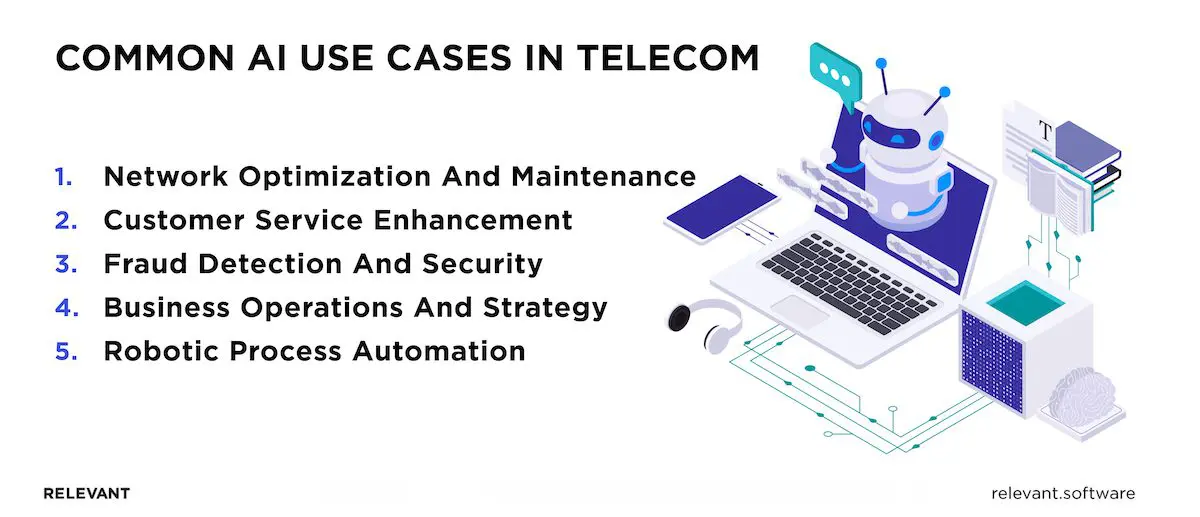AI in Telecommunications: Real-World Applications, Challenges, and Future Trends

Fueled by the explosive growth of mobile and 5G, the telecom sector has become a hotbed for modern tech, with AI in telecommunications leading the charge. Managing operations is notoriously complex, often seen as the most intricate part of the industry. To outperform others in this area, telecom operators should manage a simultaneous and coordinated approach across several business units, and they found artificial intelligence to be a facilitator in this task. With projections showing the global AI in telecommunication market ballooning to $19.1 billion by 2029, up from $2.48 billion in 2022, the stakes are high, and the rewards for integration are significant.
In fact, it’s hardly surprising as the adoption of AI in telecommunication means better service, customer support at scale, and a new era of connectivity that we’re only beginning to explore. So, more and more telecom companies opt for AI development services to meet the user demands for faster, more reliable connections. The role of AI in telecommunications grows, and we offer you to find out why the AI game is worth the candle.
Evolution of AI in Telecommunications: From Basic Automation to Advanced AI Solutions
When AI first entered telecommunications, it tackled the basics: routing calls and fraud prevention. This was just the tip of the iceberg of the technology that could do more than just follow orders—it could think, in a way. As AI’s capabilities grew, so did AI use cases in telecommunications. These days, AI in telecommunications is the ultimate multitasker that fixes network issues before we even know they exist and custom-tailors services without lifting a finger.
Thanks to leaps in deep learning and neural networks, combined with machine learning algorithms, AI now helps with network management and predictive maintenance. Today, we can enjoy a telecom network so intuitive that it repairs itself and optimizes in real time, all while making sure your binge-watching session goes uninterrupted. IoT and 5G technologies that progressed in parallel opened even more opportunities for AI/ML in telecommunications networks and made AI indispensable for effective data handling.
Key Areas of AI Application in Telecom
Given the telecom industry’s perpetual flood of extensive data, it’s only natural that artificial intelligence and telecom services match as seamlessly as coffee and mornings. Based on AI in telecommunication market trends and our experience, we outlined the typical AI application in telecommunications.

Network Optimization and Maintenance
Using real-time data analysis, AI in telecommunications can predict equipment failures before they happen, allowing for targeted maintenance and minimizing downtime. This “predictive maintenance” with smart scheduling for maintenance crews can be greatly supported by self-organizing networks (SONs). Acting like a network’s nervous system, this use of AI in telecommunications automatically adjusts power levels and configurations for network optimization. As a result, telecom companies can offer a more resilient and efficient network that keeps their subscribers connected and uninterrupted.

Customer Service Enhancement
Customer service is getting a 24/7 upgrade with the application of AI in telecommunication. Chatbots and virtual assistants powered by artificial intelligence are now available around the clock to answer user questions and troubleshoot issues, no matter the time zone.
What’s more, by analyzing customer usage patterns and preferences data, AI algorithms can give personalized recommendations for new services or data plans. A better and more customized experience with unique offers that help users get the most out of their connection will undoubtedly make your customers happier and more satisfied.
Fraud Detection and Security
Telecom fraud takes a hefty bite out of industry profits. In 2023 alone, it’s estimated to have cost $38.95 billion globally. Thankfully, fraud detection is one of the things AI in telecommunications can do extremely well. Anti-fraud analytics systems can process call and data transfer logs in real-time to spot unusual patterns that scream “fraud” and take immediate action by blocking malicious services or user accounts.

Traditional security measures no longer suffice against modern cyber-attacks, which calls for AI’s advanced learning capabilities for a more robust defense. As AI learns each time it encounters new threats and attack patterns, it can refine its ability to detect them and thwart future attempts. On top of that, telecom AI solutions automate many of the tedious tasks associated with security monitoring so human resources can take on more complex tasks.
Here, you can find How to create an AI system and what languages for AI are the best.
Business Operations and Strategy
By taking over customer service, network monitoring, and data analysis, AI in telecommunications saves time and cuts costs, positively impacting the bottom line. Automation fine-tunes your operations to run smoother, quicker, and more cost-effectively, demonstrating clear business value.
Moreover, AI’s strength in predictive modeling and data analysis helps telecom companies sharpen decision-making regarding resource use and current processes to stay agile and responsive to market changes. Hence, operators get a leaner operation that doesn’t sacrifice quality for cost savings, ensuring operational efficiency and improved service delivery, especially in areas like field service.
Robotic Process Automation (RPA)
Implemented correctly, RPA delivers immediate benefits by streamlining document processing and accelerating workflows. When combining AI software development in telecommunications with RPA solutions, companies get software that identifies anomalies and even handles basic error correction semi-automatically, boosting performance even further.

Challenges and Solutions in Implementing AI in Telecommunications
Despite the rapidly increasing market for AI in telecommunications, many companies face difficulties. Identifying relevant business applications is one thing, yet the path is filled with some other hurdles. Here are the most common challenges of AI in telecommunication industry that telecom service providers should overcome.
Data Privacy and Security Concerns
User data collected by telecom companies – call records, location information, browsing habits, etc. – is immensely valuable for optimizing network performance, personalizing services, and detecting fraud. However, the use of such personal data raises privacy concerns.
To mitigate these concerns along with security risks, organizations must balance the use of AI in telecommunication with responsible data handling. Follow industry protection regulations and be transparent with your users about what data is collected and how it’s used for AI analysis. As for security, implementing strong encryption and access controls is a must for companies of any size and in any industry.
Integration with Existing Systems
Integrating AI into the complex web of legacy telecom systems is often complicated because the existing infrastructure might not be ready for such a leap. To smooth the path for AI in telecommunications, a bit of groundwork is essential.
Start by creating a centralized database to house all the necessary data, embracing data lakes, and leaning on edge or cloud computing to manage the heavy lifting of data storage. If your data looks unorganized, it’s time for a cleanup to ensure it’s ready for AI telecom solutions. Also, double-check that your hardware and software are up to the task. Partnering with a Relevant Software company that can evaluate your old systems and lay out a clear roadmap for AI integration can turn this challenging task into a hassle-free journey.
Skilled Workforce and Training Needs
Implementing AI in telecommunications requires a team with sharp AI skills who will be able to monitor, update, and refine these systems. Plus, given AI’s rapid advancement, your team should stay on top of the latest tech trends and developments to avoid AI system mismanagement. Yet, cultivating such expertise in-house can be a slow and sometimes fruitless effort, given the scarcity of local talent. Often, finding a reliable provider who possesses both the know-how and experience in AI in telecommunication industry is a more effective route.
The Future of AI in the Telecom Industry
With telecom operators’ ongoing adoption of AI-driven automation, the market for AI in telecommunications is set to see substantial growth. Here, we outlined some of the major trends experts predict to reshape AI telecoms’ future.
- Next-Generation Networks and 5G
The rollout of 5G networks will open new opportunities for AI, ML in telecommunications networks in terms of deployment and automation of network management. AI can identify optimal locations for cell towers and other network equipment to build efficient network coverage and minimize wasted resources. Thanks to AI in telecommunications, self-optimizing networks will be able to adjust configurations to optimize traffic flow and prioritize connections based on demand. On top of that, AI, along with 5G, are the main enablers of full-fledged IoT infrastructure deployment and growth (smart cities, autonomous vehicles, etc.).

- AI and Edge Computing
Processing data right where it’s generated, on devices like sensors, base stations, or even smartphones, is the core concept of Edge Computing. By moving the processing powers of AI in telecommunications closer to the “edge” of the network, companies would be able to benefit from really low latency and faster decisions, among other things.
- AI and IoT Convergence
With billions of connected devices used globally, the Internet of Things (IoT) takes the business world by storm. And AI’s capabilities to make sense of that data and make decisions are what can reveal the full potential of this interconnected ecosystem. The blend of IoT and AI in telecommunications will bring better connectivity and deeper data insights, so vital to enable truly smart cities, self-driving cars, and innovative services.
AI in Telecommunications: Summary
The phenomenal growth of AI in telecommunications shows just how essential it has become in the industry. As more and more telecom businesses jump into the bandwagon of AI move, staying on the sidelines and hoping that customers will remain loyal isn’t an option.
Yet adopting AI technology, which is complex and dynamically evolving, is never an easy endeavor, and you shouldn’t do it alone. With the support of a reliable partner like Relevant Software that can take over the technical aspect of integrating AI in telecommunication, you can expect a smooth transition. By hiring our AI engineers with years of experience in AI and media and entertainment software development, prepare to see your telecommunications services transform.



